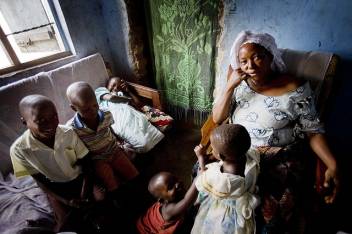 Saturday 1 December is World AIDS Day, a day to raise awareness, celebrate the success of responding to HIV and remember those who have died as a result of AIDS. The theme this year is “Getting to Zero”, in line with UNAIDS’s strategy for the HIV response.
Saturday 1 December is World AIDS Day, a day to raise awareness, celebrate the success of responding to HIV and remember those who have died as a result of AIDS. The theme this year is “Getting to Zero”, in line with UNAIDS’s strategy for the HIV response.
The ambition is to achieve a generation where no one dies of AIDS, no one newly acquires HIV, and the rights of all people living with or affected by HIV are upheld.
But what does this mean for older people? With an HIV response that often neglects those aged 50 and over, this World AIDS Day we are cautioning against the three zeros becoming four: Zero new infections, zero discrimination, zero AIDS related deaths – and zero attention paid to older people.
Zero new infections
The 2012 Global AIDS Epidemic Report UNAIDS highlighted a more than 50% drop in new HIV infections across 25 countries. This is a major success but a challenge remains where older people are concerned. Data on new infections is collected for all adults but is rarely disaggregated by age. We don’t know how many infections are occurring in people aged 50 and over and whether the number is rising or falling.
Yet some country progress reports submitted to UNAIDS do include data on older people. In Antigua and Barbuda, 25% of new infections in 2011 were in the 50 and over age group. The figure was 18% in St Lucia and in Kenya it is estimated that between 5,000 and 15,000 older people became newly infected with HIV in 2011.
A driving factor behind these figures is likely to be the fact that very few prevention programmes and little HIV information is targeted at older people. We know older people are less likely than younger people to practise safer sex, putting them at increased risk of infection. HelpAge’s work with older peer educators in Africa, aims to address some of these challenges.
Zero discrimination
Despite progress over the last 30 years in breaking the silence around HIV, people living with and affected by the virus continue to experience stigma and discrimination.
Older women are particularly affected. Because they are neglected from the HIV response, the cumulative effect of a lifetime of gender inequality and the vulnerability that comes with older age, many older women are being denied their human rights. They face discrimination on several levels including age, sex, HIV status and economic position.
In an example of the exclusion older women face, a new UNAIDS global AIDS progress indicator monitoring women experiencing physical or sexual violence is targeted only at women between the ages of 15 and 49.
This suggests older women do not suffer this type of violence and abuse yet we know from our work that this is not the case.
Zero AIDS-related deaths
Another success highlighted in the 2012 Global AIDS Report was that the number of people with access to antiretroviral therapy (ART) increased by 63% in the last two years. Global AIDS-related deaths also fell by more than 25% between 2005 and 2011.
An effect of increased treatment access is that people are living longer with HIV. As a result, a growing number of older people are living with the virus. In sub-Saharan Africa it is estimated that around 14% of all people living with HIV are aged 50 and above.
Currently, too little is known about what living with HIV in older age means. Older people with the virus will likely have other health conditions that need managing and may lead to complications.
In order to continue the great work we have started with treatment access, we now need to ensure that those who are living into older age because of ART, can live positively, healthily and happily.
Zero attention paid to older people?
While progress is being made around the three zeros we still face a significant challenge. None of the zeros will be fully achieved unless older people are included, yet the 2012 Global AIDS Report makes no reference to older people or the ageing of the HIV epidemic.
By collecting, analysing and reporting data on people aged 50 and over, addressing the human rights abuses faced by older people (particularly older women) and conducting research to better understand the needs of older people living with HIV, we can ensure we do not add a fourth zero to the list.
What next?
- Read about our work with older peer educators in Ethiopia
- Watch our animation on older women’s rights and HIV
